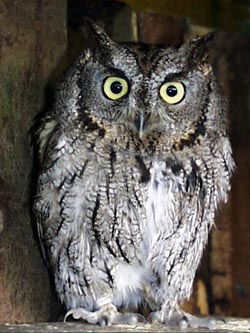Now here's a fact you probably didn't know. If you take a one-day old chick – the tiny yellow balls of fluff so beloved of Easter card designers – and cut it in two with a pair of heavy scissors, the liquid that oozes out isn't blood but thick, dark egg yolk.
This is Mother Nature's way of helping it survive the first few days until it's feeding properly. But Mother Nature didn't count on the battery farming industry, which has no need for male chickens as they can't lay eggs. Mere sentiment cannot protect these chicks – they are gassed at a day old.
This unpleasant fact is a godsend for bird of prey centres full of hungry hawks and falcons and owls. After all, birds of prey are carnivores. That's the way they're designed. What's the alternative – shut the centre and let them starve? They can be trained to do many things, but eat Linda McCartney meat-free southern-style chicken nuggets is not one of them.
Except that when birds are trained to be flown, as opposed to just sitting in an aviary, they must be kept at an optimum weight. Too heavy and they're not interested in any more food, which gives them no incentive to return to their handler. So their chicks are cut and de-yolked to stop them being too rich fare for the well-toned athletes of the falconer's stable.
Doubtless, you've already deduced from this that my delayed birthday present from
It's surprising how quickly you forget this. Before long you're not noticing the precise nature of the food placed in your thick leather glove by the falconer – you're looking for the bird that's already homing in on it. And moments later it's gone anyway, to be replaced by the beat of wings in your face and a pound or two of flapping, wild-eyed hawk or comical squawking owl on your wrist.
We flew two birds, an eagle owl and a Harris hawk. Both came to the glove from any distance whenever the wearer's arm was raised to the horizontal – some speedy work by Julian the falconer was required to make sure there was always food there by the time it arrived. I expected the process to be incredibly difficult and weighed down by fearsome health and safety warnings. In fact, with proper supervision and a well-trained bird, your role is simply to impersonate a statue. Anyone could do it – and everyone should, because it is one of the most amazing experiences I have ever had.
We also sat in on two indoor displays given by Julian for visitors to the owl sanctuary. These featured much ducking as five-foot wingspans whistled low over people's heads, a great deal of oohing and aahing as an owl the size of a tree stump hopped out of its box and sized us up with bright orange eyes, and a certain amount of crapping on the carpet. By the birds, I should make clear.
In the afternoon we worked with three more birds – falcons and hawks – that couldn't be flown to a glove but instead took food from a lure on the end of a rope. In one case the lure was spun in the air by Julian and the bird dive-bombed it, but for the other two the lure had to be dragged across the ground. Thus it was that your correspondent found himself running full tilt across a Cornish field, dragging a stuffed rabbit on a string, trying not to trip on any tussocks of grass, while a bird of prey chased him down from behind and his laughing girlfriend took photographs.
Sadly, we don't have access to a scanner until we get home so I can't post any of the pics for a while. Haven't seen them yet – but they promise to be pretty good.
All in all, it was a spectacular and inspirational day, unlike anything I have ever done before. Coming the day after I finished the first draft of my screenplay, I can honestly say I've never had a 24 hours like it.
This, by the way, is Montana – mentioned in a previous post. We got the opportunity to stroke him and this time he didn't bite anyone. But he was thinking about it – you could tell…

